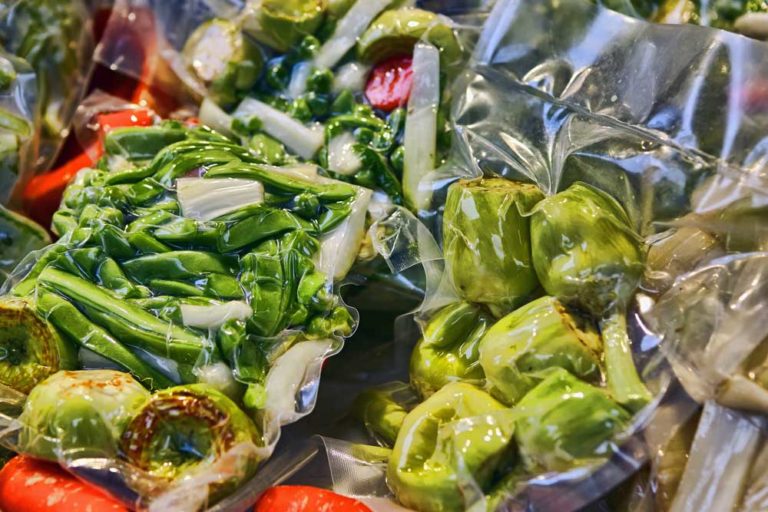Vacuum bags for food storage are an essential packaging solution used to preserve the quality, freshness and safety of food products. By removing air and sealing the contents, these bags protect food from spoilage, contamination and environmental factors. Whether you’re storing fresh produce, meat or ready-to-eat meals, vacuum bags play a significant role in maintaining product integrity.
In this article, we will explore how different barrier structures, custom film thicknesses and advanced film technologies contribute to the efficiency and effectiveness of vacuum storage bags in food packaging.

Different Barrier Structures in Storage Vacuum Bags Impact Shelf Life and Product Safety
The barrier properties of vacuum bags directly influence the shelf life and safety of the packaged food. Barrier films are designed to prevent moisture, oxygen and contaminants from entering the bag, helping to preserve the food’s freshness.
Types of Barrier Films in Vacuum Bags
- Medium Barrier (MB): These films provide a moderate level of protection, suitable for products that have a shorter shelf life, like dry snacks and some dairy items.
- High Barrier (HB): These films offer superior protection against oxygen and moisture, making them ideal for perishable foods such as meats, cheeses and ready-to-eat meals.
- High Temperature Resistance (HT): Films designed for high-temperature conditions, ideal for cooked or hot-filled foods.
- Laminated Films (LF): Multi-layered films that combine different materials to offer advanced protection against various external elements.
Each type of barrier provides specific benefits depending on the product, ensuring the food remains safe and fresh for longer.
Pigmented, Tinted and Natural Vacuum Storage Bag Options Cater to Different Packaging Needs
The color and appearance of vacuum bags are essential for both product protection and branding. Pigmented, tinted and natural vacuum bags are available to meet specific needs in food packaging.
Benefits of Different Bag Colors
- Pigmented Films: These films are used for UV protection, preventing light-sensitive products like oils and dairy from degrading.
- Tinted Films: Provide partial transparency, allowing some visibility of the product while offering a level of light protection.
- Natural Films: Clear and transparent, these bags offer visibility of the food inside, which is ideal for fresh produce and packaged bakery items.
These color variations help protect products and create packaging that aligns with branding and product visibility.
Custom Film Thickness in Vacuum Bags Affects Packaging Strength and Functionality
The thickness of the film in vacuum storage bags impacts both their strength and functionality. Thickness is measured in microns and selecting the right thickness is crucial for ensuring the packaging meets the product’s requirements.
The Impact of Film Thickness
- Thin Films (40-70 microns): These are suitable for lightweight items and short-term storage. They offer cost-effective solutions for products with a shorter shelf life.
- Medium Films (70-120 microns): These films are ideal for a variety of food products, providing a good balance between strength and cost. They are commonly used for meats, cheeses and dairy products.
- Thick Films (120-200 microns): These are best for heavy-duty applications, such as bulk food packaging or products that require extra protection during long-term storage.
The right thickness ensures the packaging protects the product while balancing strength, flexibility and cost.
Storage Vacuum Bags Use Advanced Film Technology for Efficient Packaging
Advanced film technology plays a significant role in improving the functionality and quality of vacuum bags for food storage. Techniques like CI Flexo and Roto Gravure printing allow for high-quality printing, enhancing the packaging’s appearance and providing opportunities for branding.
Advanced Printing for High-Quality Branding
- CI Flexo Printing: This process uses flexible plates to print on vacuum bags, offering vibrant colors and cost-effective production for simple designs.
- Roto Gravure Printing: This technique is ideal for high-definition printing with multiple colors, making it perfect for detailed branding and product information.
Both technologies enhance the aesthetic appeal of vacuum bags, making them stand out in retail settings and helping brands communicate product value.
Vacuum Bags for Food Storage Improve Food Safety Standards
Food safety is a critical concern and vacuum bags help maintain the integrity of the packaging and prevent contamination. They provide an airtight seal that limits exposure to bacteria, mold and other contaminants, improving food safety.
- Airtight seal: By removing air from the packaging, vacuum bags reduce the likelihood of microbial growth, preserving the food’s safety.
- Contaminant protection: Vacuum storage bags protect against external factors like dust, insects and bacteria, ensuring that the food remains safe and fresh for a longer period.
- Regulatory compliance: Many food safety regulations require certain packaging standards to prevent contamination. Vacuum bags help meet these standards, ensuring compliance in the food industry.
Conclusion
Vacuum bags for food storage provide a comprehensive solution for preserving freshness, ensuring safety and enhancing branding. From barrier properties that impact shelf life to advanced printing technologies that improve visual appeal, vacuum storage bags offer unmatched flexibility and performance. By selecting the right film structure, thickness and color, manufacturers can tailor their packaging to meet specific needs, whether it’s for long-term storage, product visibility or branding.
The vacuum bag packaging industry continues to evolve with advancements in film technology, providing more efficient and cost-effective packaging options for the food industry. As a result, vacuum bags remain a crucial tool for maintaining food quality, safety and consumer satisfaction.
